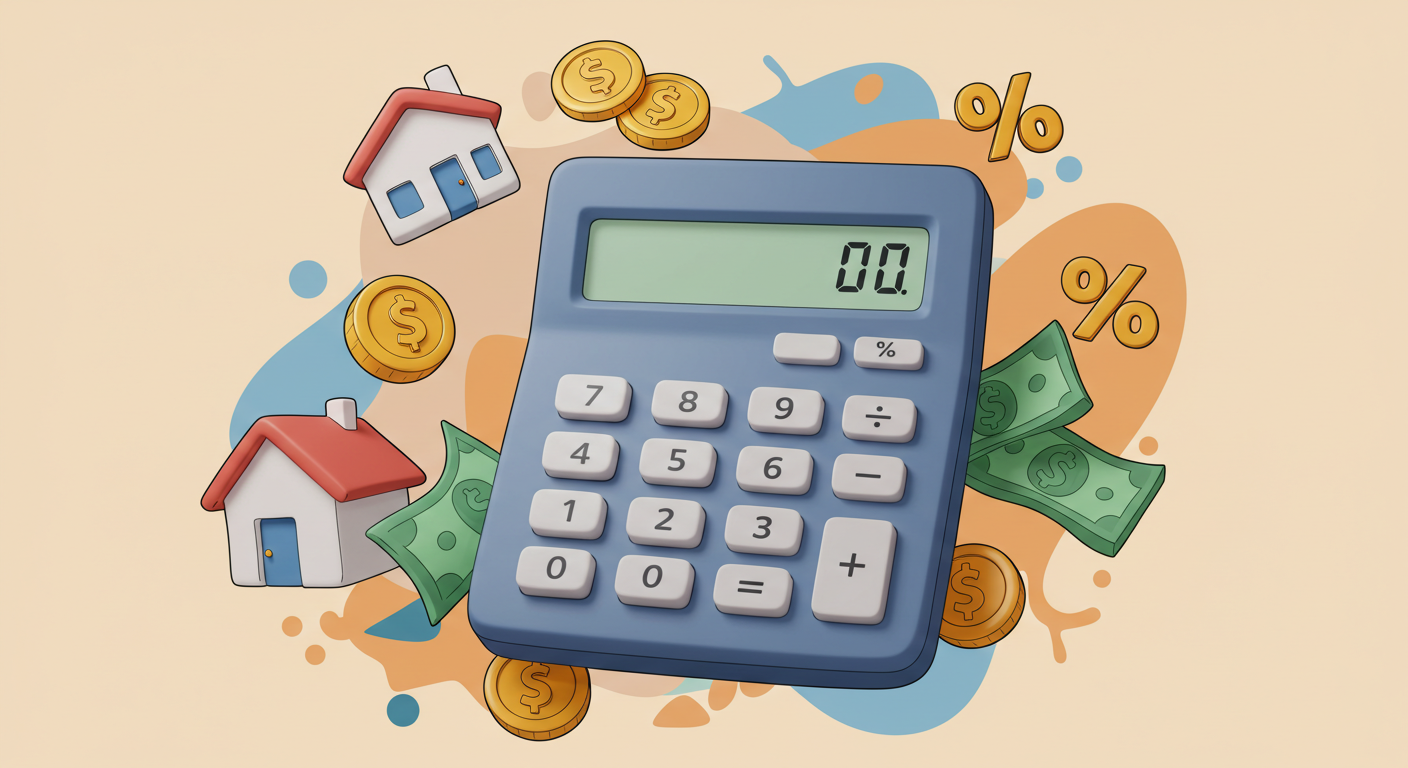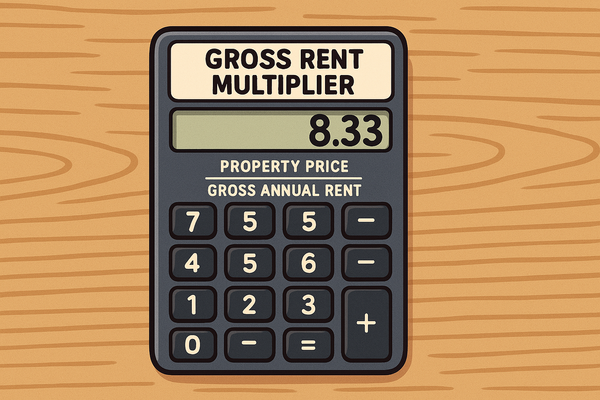Understanding Cap Rates: The Essential Metric for Property Management Success
Master the capitalization rate (cap rate) - the essential metric for property managers to evaluate performance, demonstrate value, and make smarter operational decisions.

The capitalization rate (cap rate) is a fundamental financial metric that represents the ratio of a property's net operating income (NOI) to its current market value, expressed as a percentage. For property managers and landlords, cap rates serve as a critical tool for evaluating investment performance, comparing properties, and making informed business decisions that directly impact profitability.
Whether you're managing a small residential portfolio or overseeing large commercial properties, understanding cap rates provides you with a standardized method to assess property performance, communicate value to owners, and identify opportunities for operational improvements.
This article breaks down everything property managers need to know about cap rates – from basic calculations to advanced strategies – helping you leverage this powerful metric to maximize returns and demonstrate your value to clients.
Definition and Background
What Exactly Is a Cap Rate?
A capitalization rate, commonly referred to as a "cap rate," is a measure that evaluates a property's potential return on investment, expressed as a percentage. At its core, the cap rate represents the ratio between a property's net operating income (NOI) and its current market value or purchase price.
The formula is straightforward:
Cap Rate = (Net Operating Income / Current Market Value) × 100
For example, if a property generates $50,000 in annual NOI and is valued at $800,000, the cap rate would be 6.25% ($50,000 ÷ $800,000 × 100). You can use a Cap Rate Calculator for Real Estate Investments to quickly run these numbers for different properties.
In financial terms, the cap rate formula closely resembles the formula used to value a perpetuity - an income stream that runs indefinitely. This similarity underscores the cap rate's role in expressing the relationship between income and value from a long-term perspective.
CAP RATE FORMULA BREAKDOWN
Net Operating Income (NOI)
- Total Annual Rental Income
- Additional Income Sources
- Parking, laundry, vending, storage
- Operating Expenses
- Property management: 8-12%
- Property taxes: 15-25%
- Insurance: 5-10%
- Utilities: 5-15%
- Maintenance: 5-15%
- Repairs: 5-10%
- Landscaping: 3-7%
- Legal/accounting: 2-5%
- Vacancy allowance: 5-8%
- = Net Operating Income
Property Value
- Purchase Price/Acquisition Cost
- - OR -
- Current Market Value
- Valuation Methods:
- Comparable Sales Approach
- Income Approach (Capitalization Method)
- Replacement Cost Approach
Example Calculation
Annual Rental Income: $120,000
Additional Income: $5,000
Total Operating Expenses: $45,000
NOI: $80,000
Property Value: $1,000,000
An 8% cap rate indicates that the property will generate an 8% return on investment in the first year of ownership (before mortgage payments).
Cap Rate Ranges:
• Residential Properties: 4-10%
• Commercial Properties: 5-12%
Lower cap rates typically indicate lower risk and higher property values, while higher cap rates may suggest higher risk but potentially higher returns.
Key Components of the Cap Rate Formula
To accurately calculate a cap rate, you need to understand its two primary components:
- Net Operating Income (NOI): This represents the property's total annual income minus all operating expenses. Income typically includes rental revenue and other income sources like parking fees or laundry facilities. Operating expenses encompass property taxes, insurance, maintenance, repairs, utilities, management fees, and other costs. Importantly, NOI excludes mortgage payments, capital expenditures, and depreciation.
- Current Market Value: This represents the property's present worth in the marketplace. For existing investments, this is typically the current appraised value or recent sales price. For potential acquisitions, it's the purchase price being considered.
Evolution and Industry Adoption
Cap rates have become increasingly prominent in property management over time, evolving from a simple valuation metric to a sophisticated tool that reflects market sentiment, risk assessment, and growth expectations. Today, property managers regularly use cap rates to:
- Evaluate property performance
- Justify management decisions to owners
- Analyze potential acquisitions
- Compare properties across different markets
- Assess the impact of operational improvements
Significance in Property Management
Why Cap Rates Matter in Day-to-Day Operations
For property managers, cap rates transcend basic investment metrics to become powerful operational tools. When used effectively, they provide a clear framework for decision-making that impacts daily operations, long-term planning, and client relationships.
Cap rates help property managers:
- Demonstrate Value: When operational improvements increase NOI without changing property value, the resulting higher cap rate provides tangible evidence of management effectiveness.
- Guide Budget Priorities: By understanding how different expenses impact NOI (and thus cap rates), managers can prioritize budget allocations that maximize returns.
- Set Appropriate Rental Rates: Cap rate analysis helps determine optimal rental pricing strategies to balance occupancy and income.
- Justify Fee Structures: Property managers who demonstrate their impact on cap rates through improved operations can justify higher management fees.
Impact on Profitability and Performance Assessment
Cap rates provide a standardized method to assess property performance across different asset types and markets. According to recent market data, national average cap rates vary significantly by property type, with multifamily at 6.10%, industrial at 7.60%, office at 8.90%, and retail at 7.00% as of Q3 2024.
These variations highlight important distinctions in market perception of risk and growth potential, directly impacting investment strategies. For property managers, understanding these benchmarks provides context for performance assessment and goal-setting.
National Average Cap Rates by Property Type (Q3 2024)
Including typical market ranges
Understanding Cap Rate Risk Correlation
Lower cap rates typically indicate lower perceived risk and higher property values. Higher cap rates may suggest higher risk but potentially higher returns.
5-Year Historical Trends (2020-2024)
Risk Assessment Framework
Perhaps most importantly for property managers, cap rates serve as a compact indicator expressing expectations about investment return and rental growth. Higher cap rates typically signal higher perceived risk but also higher potential returns.
This relationship creates a powerful framework for communicating with owners about risk-reward tradeoffs in different management strategies.
For instance, a property manager might explain to an owner that more aggressive tenant screening could reduce rental delinquency risk, potentially lowering the perceived risk profile of the property and justifying a lower cap rate (and thus higher property value) in the future.
Practical Applications
Scenario 1: Using Cap Rates to Demonstrate Management Value
Situation: You're managing a commercial property valued at $6,000,000 that generates $500,000 in annual rental income with $100,000 in operating expenses (NOI of $400,000). The current cap rate is 6.67%.
Application: Through improved tenant retention strategies and operational efficiencies, you reduce vacancy rates and trim unnecessary expenses, increasing annual rental income to $530,000 while maintaining operating expenses at $100,000, resulting in a new NOI of $430,000.
Steps Taken:
- Calculate the new cap rate: $430,000 ÷ $6,000,000 = 7.17%
- Calculate the increased property value at the original cap rate: $430,000 ÷ 6.67% = $6,447,526
- Present both metrics to the owner, demonstrating a value increase of $447,526
Outcome: You've provided concrete evidence of your management value, showing both improved cash flow (NOI increase) and property value enhancement.
Scenario 2: Evaluating a Potential Property Acquisition
Situation: An owner client is considering purchasing an additional rental property priced at $325,000 with a monthly rental income of $2,000 ($24,000 annually) and estimated annual operating expenses of $5,800.
Application: As their property manager, you need to analyze whether this acquisition aligns with their investment goals and current portfolio performance.
Steps Taken:
- Calculate the property's NOI: $24,000 - $5,800 = $18,200
- Calculate the cap rate: $18,200 ÷ $325,000 = 5.6%
- Compare this cap rate to similar properties in the portfolio and market
- Consider how operational improvements could enhance this property's performance
Outcome: You advise the owner that while the 5.6% cap rate is lower than market average for similar properties (suggesting potential underperformance or lower risk), your management expertise could improve operational efficiency to boost the return closer to 6.5%.
Scenario 3: Using Cap Rates to Prioritize Capital Improvements
Situation: You manage multiple properties and need to prioritize capital improvement projects with limited budget resources.
Application: By calculating the projected cap rate impact of different improvements, you can prioritize those offering the highest ROI.
Steps Taken:
- For each proposed improvement, estimate:
- Implementation cost
- Projected NOI increase (through higher rents, lower expenses, or both)
- Resulting impact on cap rate
- Rank projects by ROI potential
- Create a phased implementation plan based on budget constraints
Outcome: You implement the highest-impact improvements first, maximizing return on capital deployment while providing owners with data-driven justification for expenditures. This approach can include Maximizing Property Value with Amenities that directly impact NOI.
Legal and Compliance Considerations
Regulatory Framework for Cap Rate Applications
Property managers must understand how cap rates intersect with legal and regulatory requirements, particularly in contexts where cap rates influence formal property valuations. In many jurisdictions, property valuation methods must follow "generally accepted appraisal methods and techniques" as prescribed by state tax codes.
For example, Texas provides specific guidelines through Tax Code sections 23.53 and 23.74, which prescribe methods for determining cap rates used to calculate agricultural land and timberland values.
As of 2025, Texas appraisal districts must use a 10.00% cap rate for agricultural or open-space land and a 7.75% cap rate for appraising timberland.
Documentation Requirements
Property managers should maintain thorough documentation regarding cap rate calculations, particularly when:
- Reporting to property owners
- Marketing properties for sale or lease
- Participating in formal appraisal processes
- Submitting information for tax assessments
- Applying for financing
Appraisers must maintain consistency in cap rate derivation methodology, and cap rates must be derived from comparable properties in a manner consistent with their intended application.
For property managers, this means keeping detailed records of the data sources and methodologies used in cap rate calculations, ensuring transparency and defensibility.
Potential Legal Pitfalls
Several legal considerations arise when working with cap rates:
- Misrepresentation Risk: Inaccurate cap rate calculations shared with potential buyers or investors could constitute misrepresentation, potentially resulting in legal liability.
- Fiduciary Responsibility: Property managers have a fiduciary duty to provide accurate financial analysis to property owners. Errors in cap rate calculations that lead to poor decision-making could breach this duty.
- Tax Compliance Issues: Inconsistent cap rate methodologies used in tax-related property valuations might trigger audits or reassessments.
- Lease Agreement Implications: Cap rate projections that influence lease terms must be carefully documented to avoid contractual disputes.
The consequences of non-compliance can include financial penalties, professional liability claims, damage to professional reputation, and potential license revocation in regulated property management contexts.
Best Practices
Practice 1: Establish Consistent Calculation Methods
Implementation Steps:
- Develop a standardized NOI calculation template that clearly identifies all income sources and expense categories
- Ensure all team members use identical methodology when calculating cap rates
- Review calculation methods annually to incorporate industry best practices
- Maintain detailed documentation of all assumptions used in calculations
- Utilize Strategic Amenity Selection for Rental Properties to identify income-generating improvements
Property managers should calculate NOI by determining total annual income, then subtracting all operating expenses (excluding mortgage principal and interest). For market value, obtain accurate figures through formal appraisal, broker's opinion of value, or recent sales price.
Practice 2: Benchmark Against Market Standards
Implementation Steps:
- Monitor cap rate trends across similar property types in your specific geographic market
- Create comparative analyses showing how your managed properties perform relative to market benchmarks
- Set performance targets based on achievable improvements relative to these benchmarks
- Communicate benchmark comparisons to owners quarterly
National average cap rates by property type (Q3 2024) provide useful reference points: multifamily (6.10%), industrial (7.60%), office (8.90%), and retail (7.00%). However, local market variations can be significant, with prime markets like San Francisco showing much lower rates than markets like Chicago.
Practice 3: Build Conservative Financial Models
Implementation Steps:
- When analyzing potential acquisitions, use slightly higher cap rates than current market rates for terminal value calculations
- Account for potential market cycles by modeling multiple scenarios with varying cap rate projections
- Include sensitivity analyses showing how cap rate changes impact property values
- Build in downside protection by using higher cap rates for terminal value calculations than current market rates
This approach provides realistic expectations for property owners while creating buffer against market volatility.
Practice 4: Focus on NOI Growth Strategies
Implementation Steps:
- Target operational improvements that increase NOI by at least 25% during a typical property hold period
- Identify and implement rent optimization strategies based on market conditions
- Develop expense management protocols that maintain property quality while minimizing costs
- Create preventive maintenance programs that reduce long-term operating expenses
CAP RATE IMPROVEMENT DECISION TREE
Increase Revenue
Decrease Expenses
Cap Rate Improvement ROI Calculator
Example Calculation:
For a $1,000,000 property:
- Initial cap rate: 6.00%
- Implement rent optimization: +0.30%
- Improve property condition: +0.25%
- New cap rate: 6.55%
- Value increase: +$91,603
ROI Formula:
1. Select improvement strategies
2. Sum the cap rate impacts
3. Calculate value increase:
Value Increase = Property Value × (Cap Rate Improvement ÷ Original Cap Rate)
By focusing on growing NOI rather than speculating on cap rate compression, property managers can deliver reliable performance improvements even in changing market conditions.
Practice 5: Communicate Cap Rate Implications Effectively
Implementation Steps:
- Create visual dashboards showing how operational improvements impact cap rates and property values
- Develop regular reporting templates that highlight cap rate trends over time
- Educate owners on how cap rates influence their investment returns
- Use cap rate analysis to justify management decisions and fee structures
Effective communication transforms cap rate analysis from abstract number-crunching into a powerful tool for demonstrating value and building client relationships.
Related Concepts
Gross Rent Multiplier (GRM)
The Gross Rent Multiplier is a simpler metric than cap rate, focusing on gross income rather than NOI. GRM is calculated by dividing a property's price by its gross annual rental income.
How it relates to cap rates: While cap rates provide deeper insight by accounting for operating expenses, GRM offers a quick initial screening tool. Property managers proficient with both metrics can efficiently evaluate properties at different stages of analysis.
Return on Cost
Return on Cost differs from cap rate by considering development or renovation costs rather than market value. It's calculated by dividing NOI by the total cost to acquire and improve a property.
How it relates to cap rates: For property managers overseeing renovations or repositioning projects, understanding both metrics helps demonstrate value creation. While cap rates show current performance relative to market value, return on cost highlights efficiency in capital deployment.
Weighted Average Cost of Capital (WACC)
WACC represents the average rate a company is expected to pay to finance its assets, incorporating both debt and equity.
How it relates to cap rates: In sophisticated property management operations, particularly for larger portfolios or institutional owners, cap rates should exceed WACC to ensure value creation. Property managers who understand this relationship can better align their operational strategies with owners' financial objectives.
Internal Rate of Return (IRR)
IRR measures the profitability of investments by calculating the discount rate that makes the net present value of cash flows equal to zero.
How it relates to cap rates: While cap rates provide a snapshot of performance at a specific point in time, IRR captures performance over the entire investment period. Property managers who understand both metrics can better communicate how current operational decisions impact long-term investment returns.
Common Questions
What is a good cap rate for rental properties?
A "good" cap rate typically ranges between 5% and 10% for rental properties, though this varies significantly by location and property type. In prime locations, even 4-5% can be considered good despite seeming low compared to secondary markets.
The appropriate cap rate depends on:
- Property type (office, retail, industrial, multifamily)
- Geographic location
- Current economic conditions
- Investor's risk tolerance
As a property manager, focus on whether the cap rate aligns with owner investment objectives rather than chasing arbitrary "good" numbers.
How do interest rates affect cap rates?
Rising interest rates typically increase the cost of capital, contributing to rising cap rates. This relationship exists because investors generally expect higher returns when their borrowing costs increase.
For property managers, rising interest rates often signal:
- Increased focus on operational efficiency to maintain property values
- Potential cap rate expansion (and corresponding value compression)
- Opportunities to demonstrate value through NOI improvements that offset value declines
- Changing owner priorities regarding hold periods and exit strategies
Understanding this relationship helps property managers prepare for and navigate changing economic environments.
How can property managers improve cap rates?
Property managers can improve cap rates through two primary approaches:
- Increase NOI:
- Optimize rental rates based on market conditions
- Reduce vacancy through improved tenant retention
- Implement more efficient expense management
- Add ancillary income streams (storage, parking, services)
- Strategically upgrade units/spaces to command higher rents
- Reduce Perceived Risk:
- Improve tenant quality through enhanced screening
- Extend average lease terms for greater income stability
- Implement preventive maintenance to reduce future capital needs
- Enhance property appearance and curb appeal
- Improve documentation and reporting transparency
- Focus on Tenant Satisfaction and Rental Performance to reduce turnover
The most effective strategy typically combines both approaches, creating durable value through operational excellence.
Conclusion
Understanding and effectively utilizing cap rates represents a significant competitive advantage for property managers. This fundamental metric provides a standardized framework for evaluating property performance, communicating value to owners, and making data-driven management decisions.
By mastering cap rate analysis, property managers can:
- Demonstrate their direct impact on property values through operational improvements
- Make more informed recommendations about acquisitions, dispositions, and capital improvements
- Set appropriate rental rates that balance short-term cash flow with long-term value
- Communicate more effectively with sophisticated owners and investors
- Position themselves as strategic advisors rather than just day-to-day operators
The most successful property managers don't just track cap rates—they actively work to influence them through strategic operational improvements that enhance NOI while reducing risk. This proactive approach transforms property management from a service business into a value-creation partnership.
Recommended Resources for Further Learning
- Real Estate Finance and Investments: Risks and Opportunities by Peter Linneman
- Commercial Real Estate Analysis and Investments by David M. Geltner and Norman G. Miller
- The Institute of Real Estate Management (IREM) - www.irem.org
- Urban Land Institute - www.uli.org
- CCIM Institute - www.ccim.com
Take the next step in your professional development by incorporating systematic cap rate analysis into your property management approach. Your owners will appreciate the clarity, transparency, and value-focused perspective this brings to your services.





